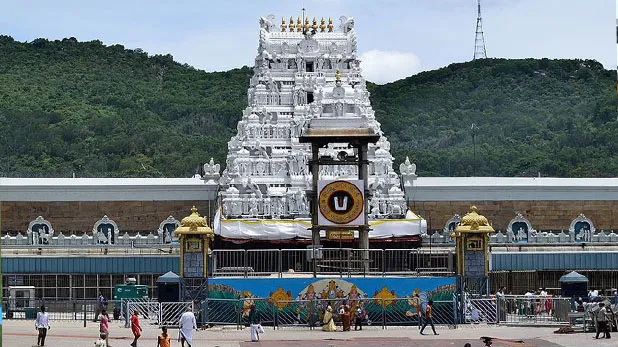
The Tirupati Balaji Temple at Tirumala, officially known as the Tirumala Venkateswara Temple, is one of the most popular and revered Hindu pilgrimage sites in the world. It is dedicated to Lord Venkateswara, an incarnation of Vishnu. The temple is situated on Tirumala Hill, which is part of the Seshachalam Hills in Andhra Pradesh, India.
The exact date of the temple’s construction is unknown, but it is believed to have been built around the 3rd century CE. According to legends, the temple was built by Tondaman Chakravarty, a king of the Thondaman dynasty. He is said to have built the gopuram (gateway tower) and prakara (outer enclosure) of the temple after seeing Lord Vishnu in a dream.
The temple was later expanded and renovated by many other dynasties, including the Pallavas, Cholas, and Vijayanagara Empire. The Pallavas were the first to make significant contributions to the temple. They built the inner shrine, known as the Ananda Nilayam, and installed the self-manifested (swayambu) statue of Lord Venkateswara.
The Cholas also made significant contributions to the temple. They built the four gopurams (gateway towers) at the four entrances to the temple complex. They also donated gold and jewels to the temple.
The Vijayanagara Empire made the most significant contributions to the temple. They built the majority of the structures in the temple complex, including the Rajagopuram (main gateway tower), the Vimana (main shrine tower), and the Ardha Mandapam (hall). They also donated a large amount of gold and jewels to the temple.
The temple complex has been expanded and renovated many times over the centuries. Today, it is one of the largest and most opulent Hindu temples in the world. It covers an area of 16 acres and consists of several shrines, halls, and mandapams (pavilions).
The main shrine, the Ananda Nilayam, houses the self-manifested (swayambu) statue of Lord Venkateswara. The statue is made of black stone and is believed to have appeared on its own on Tirumala Hill.
The temple complex also has several other shrines dedicated to various Hindu deities, including the Garuda Mandapam (a hall dedicated to Garuda, the vehicle of Lord Vishnu), the Kalyanotsava Mandapam (a hall dedicated to the celestial wedding of Lord Venkateswara and Padmavathi, his consort), and the Bangaru Vakili (a golden gate that leads to the Ananda Nilayam).
The Tirumala Venkateswara Temple is administered by the Tirumala Tirupati Devasthanams (TTD), a trust established by the Government of Andhra Pradesh. The TTD is one of the richest religious organizations in the world and oversees the management of the temple and its vast assets.
The TTD is responsible for:
- The day-to-day administration of the temple
- The maintenance of the temple complex and its assets
- The conduct of religious rituals and festivals at the temple
- The provision of accommodation and other facilities to pilgrims
- The welfare and education of the employees of the TTD
The Tirumala Venkateswara Temple is one of the most popular pilgrimage sites in the world. It attracts millions of pilgrims from all over the world every year. The temple is a major source of revenue for the Government of Andhra Pradesh and the TTD.
The economic impact of the Tirumala Venkateswara Temple:
- The temple complex employs over 20,000 people.
- The temple generates over $1 billion in revenue every year.
- The temple is a major source of foreign exchange earnings for the Indian government.
- The temple contributes to the development of the local economy by attracting tourists and pilgrims.
The Tirumala Venkateswara Temple is a cultural and religious icon for millions of Hindus around the world. It is a symbol of India’s rich cultural heritage and its vibrant religious traditions.


